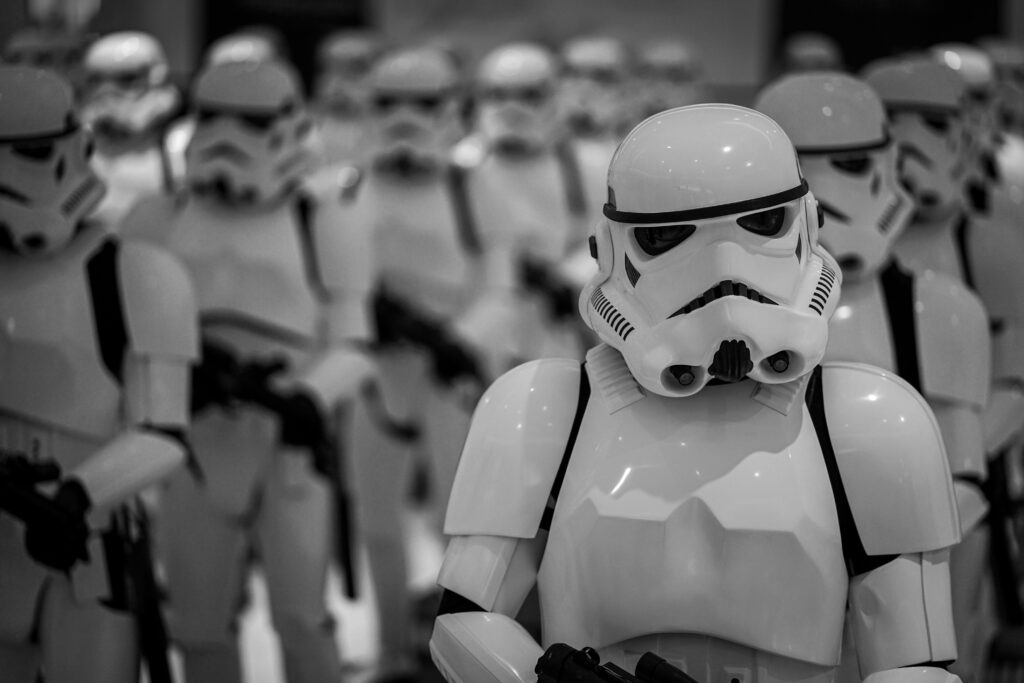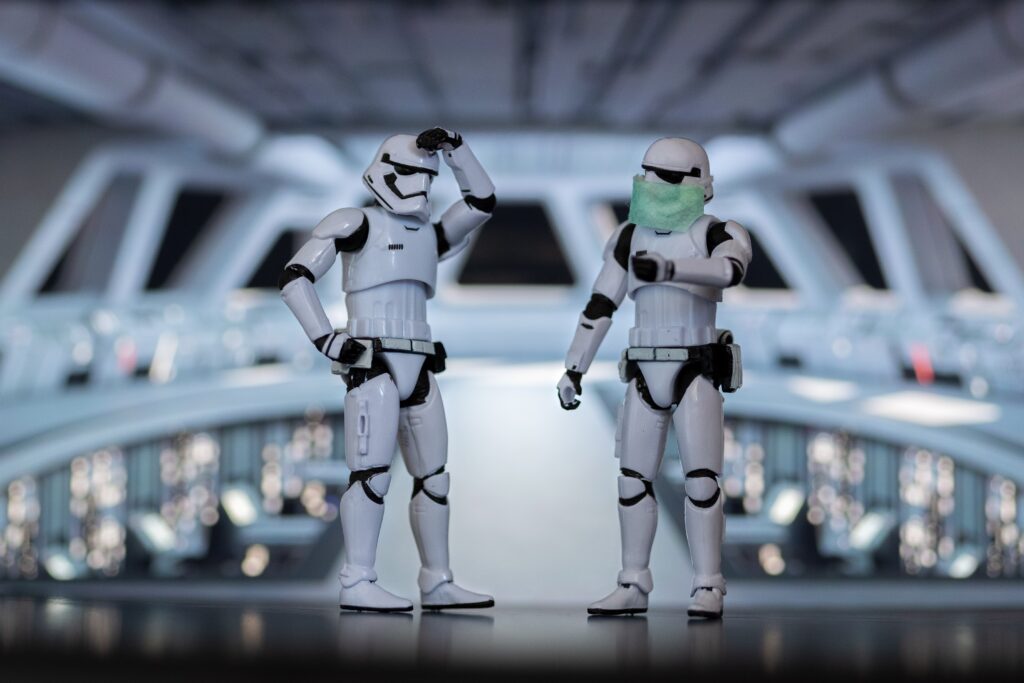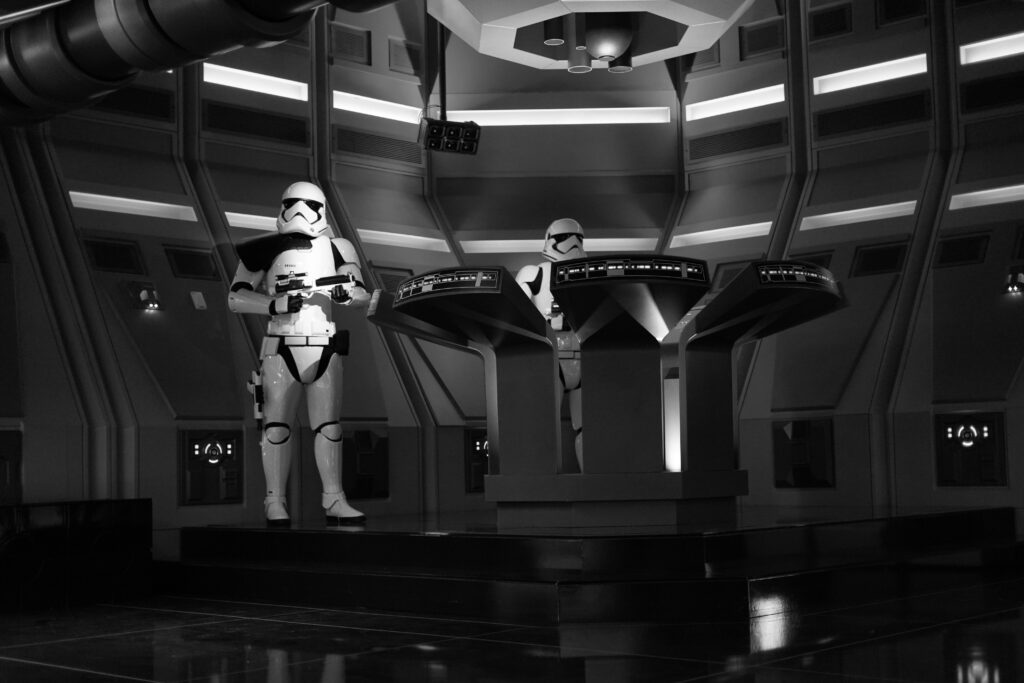Top 10 Health And Safety Violations In Star Wars: Death Star? More Like Death Trap!

The Galactic Empire. Known across a galaxy far, far away for bringing peace and order to countless planets and star systems.
Or so they’d have you believe.
While their galactic conquest often takes the spotlight, the Empire does provide many people with jobs. With such a large organisation and a huge number of employees, you’d think they have great Health and Safety guidelines and processes. After all, anything that can help with managing all these people has got to be a priority, right?
Stormtroopers might be the face of their workforce, but pilots, technicians, cleaners and many more jobs are available across the many worlds they govern – not to mention the starships travelling between them.
Then, of course, there’s the Death Star, a space station the size of a small moon. That means a lot of job opportunities.
Why Would You Want To Work On The Death Star?
With an estimated population of over 1.1 million personnel, the Death Star requires a large workforce. This means there are possibilities to advance your career if you perform well. As the largest structure outside of a planet, there will always be jobs to be done, from maintenance to repair to management and everything in between.
It’s size also makes it a stable option, as there are few ships or weapons that can rival or threaten the Death Star. For those looking for stability and job security, there are fewer better options anywhere in the universe – if you can look past the oppression and tyrannical rule that comes with being a part of the Empire.
10 Risks The Death Star Health And Safety Manager Should Address
Despite the stability and job security a posting on the Death Star can bring, there are also numerous Health and Safety hazards that seem to have gone unnoticed. Perhaps because there are so many workers that it’s a logistical nightmare to resolve them throughout the whole space station, or maybe it’s because this is considered normal – whatever the reason, we believe these issues could be solved with proper Health and Safety risk assessments.
We look at some of the most obvious risks below, and they really call into question why anyone would want to work on the Death Star in the first place.
1. Choking Hazards
When you think of choking hazards, it’s normally from eating or drinking – followed by a lot of coughing and trying to dislodge whatever got stuck. It’s a hazard we all forget about because it’s a risk every time we eat or drink.
On the Death Star, however, there’s another choking hazard to watch out for – the boss!
Darth Vader is not known to tolerate failure, and the Dark Lord of the Sith knows there are plenty of people onboard the Death Star who will take an opportunity when one comes. While his interactions with employees outside of the leadership team might be limited, it does not bode well to disappoint him or there might be another choking victim – without Grand Moff Tarkin to reign him in.
2. Tripping Hazards
The MSE-6 repair droids, commonly known as mouse droids, are a common sight across the Death Star. Designed to carry out certain repair and maintenance tasks, they are small enough to be ignored by most people – although they can also be used to lead personnel to the right locations.
In the chaos of battle or urgent situations, however, these droids can blend into the dark floor and it would be easy to trip over them. That could cause an even bigger pile up if the people behind don’t realise what’s happened in time.
Unless you constantly watch the floor, you wouldn’t be the only one who’s tripped over one of these droids – and you won’t be the last.
3. Guy Who Bonked Head On The Door

While looking down and watching for trip hazards is one way to navigate the Death Star, it’s not the only risk.
Doorways are set at a standard height and if you are too tall to walk through them with a straight back, it’s going to be a problem at every doorway, as more than one Stormtrooper has discovered.
The helmets and armour should protect them from serious injury but they will be distracted for a few seconds, giving enemies the chance to attack first, or they might block the doorway for others. Neither is a good option and there isn’t much that can be done to change the size of the doors once the Death Star has been constructed.
4. Bottomless Pits

For a large battle station, the Death Star has a lot of pits to fall down. From the hangar housing the Millennium Falcon to the Emperor’s throne room on the Death Star II to the garbage chute – there are plenty of places you could find yourself falling into the abyss. You might be curious as to where these lead, but it’s not a curiosity we’d advise you to indulge in, as you might not return.
In some cases, we’ve seen elevated platforms rise up to deliver troops and supplies, but where do they come from when there are other elevators to use? Not only that, but these platforms don’t cover the entire hole!
5. No Guardrails
Speaking of holes, most of them don’t have guardrails, either. That makes it even easier to fall down. The slightest tremor could be the beginning of a long fall that won’t end well for anyone.
The tractor beam controls are attached to pillars with very thin ledges to walk around, with nothing to stop you from falling off. Even most of the bridges seen don’t have guardrails. This is a trend seen further on the Empire’s ships, such as the Star Destroyers, where on the command deck there are no rails to stop officers falling into the lower sections.
While the Emperor’s throne room discussed previously does have guardrails, this seems to be the only place where they can be found, and they didn’t seem very sturdy.
6. No Protection From The Beam

Another area on the Death Star that could use guardrails is in the main beam weapon sections. Not only is this a large drop, but there’s a powerful laser passing through. There’s no guardrail, screen or any other type of protection offered to the workers in this area.
You’d expect that everyone would know well in advance that the weapon is due to fire, but if it takes you by surprise, there’s nothing to protect you from falling off the platform. You’d have to hope you could avoid the beam as you fell, or you’d have no hope of surviving.
7. Ear Protection For The Operators
Technicians and weapon operators in this area need to be wary of another hazard, as there’s no ear protection offered. We can see that the noise is loud whenever it fires and being exposed to this noise often is going to cause damage.
There may be some fantastic medical technology to use, but keeping workers safe would lower the time spent waiting for treatment and reduce the cost involved. More adequate protection in this area in general would be of use, as a screen or wall would stop people falling and block some of the noise – not to mention any other radiation or energy bursts that may happen.
8. Waste Disposal
Dianogas are omnivorous creatures that can break down biological waste into useful minerals, which explains why they have been brought onboard the Death Star. It might not seem logical to have such dangerous creatures onboard, but it’s not often anyone would go into a trash compactor unprepared.
That said, they would have to be checked – or there would be no need for a door into the garbage compactor. Xeno-biology has never been the most prominent of careers in the Empire, but there must be specialists onboard to deal with the Dianoga and stock them being crushed. How these are stored and transported is a risk itself.
9. Do They Have An Accident Log
With so many risks and hazards identified (and many more not discussed yet), an organisation like the Galactic Empire would have excellent processes that are rigorously followed. However, the amount of hazards seen on the Death Star with no action taken puts this into question.
An accident log, for example, is a basic method of tracking accidents and incidents that occur so changes can be made to prevent them from happening again. With such a large battle station, one log might not be enough, and multiple logs could be confusing for people to work with.
A centralised system could help but this would need a lot of work put into it, and that might detract from the galactic conquest.
10. Thermal Exhaust Port
While not strictly a Health and Safety hazard for individual personnel, the thermal exhaust port is a huge risk – possibly the biggest on the whole station. If a reaction is triggered, everyone onboard is at risk of losing their jobs, if not death.
This is a risk that should have been spotted during the design stage and again during the station’s construction. While there were likely many different teams collaborating on the Death Star, at least one should have pointed out this flaw.
While the risk was considered minimal once it was identified, the action taken to prevent its exploitation was minimal compared to the size of the force onboard the station. This overconfidence is the perfect example of why proper Health and Safety strategy is needed.
Managing Health And Safety Risks In Your Business
If the Empire had completed risk assessments, a lot of these issues could have been avoided or prevented. A Health and Safety strategy by an experienced manager or consultant would have gone a long way to making the Death Star safer – and they can do the same for your business, too.
To find out more about how a Health and Safety consultant can help, get in touch with the team at Rhino Safety and we’ll work with you to make sure you have all your risks covered.
